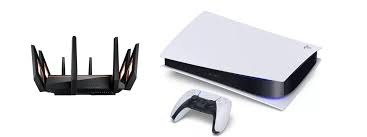Your PS5 is built for speed, performance, and immersive online gaming—but if your router isn’t up to the task, none of that power truly shines. Lag spikes, slow downloads, and connection drops can all be traced back to one thing: your network setup. Whether you’re downloading massive titles, streaming in 4K, or battling in high-stakes multiplayer matches, the right router and optimized network settings are critical to unlocking your console’s full potential.
Many gamers overlook the router’s role, relying on outdated or ISP-provided models that can’t handle modern gaming demands. The result? PS5 network issues, NAT problems, and sluggish performance—even on fast internet plans.
This guide is here to fix that. We’ll walk you through the best routers for PS5 gaming, what features to look for, and how to configure your network settings for faster, smoother gameplay. Whether you’re on Wi-Fi or Ethernet, casual or competitive, this is your one-stop roadmap to a lag-free PS5 experience.
1. Why Your Router Matters for PS5 Gaming
Your router is the heart of your online gaming setup—and when it comes to the PlayStation 5, it can either make or break your experience. Whether you’re downloading massive games, streaming in 4K, or battling it out in online multiplayer, the quality of your router for PS5 gaming plays a massive role in how smooth (or frustrating) things will be.
A weak or outdated router can cause high ping, lag spikes, random disconnects, and painfully slow downloads. Even if you have a fast internet plan, a poor-performing router can act as a bottleneck—limiting your PS5’s speed and stability.
That’s where gaming routers come in. Unlike standard routers, they’re built to handle heavy traffic, prioritize gaming devices, and minimize latency. Many offer features like Quality of Service (QoS), dual-band or tri-band Wi-Fi, and low-latency gaming modes—all designed to give your PS5 the bandwidth and priority it deserves.
If you’ve ever experienced lag during a critical match, or waited hours for a game to download, your router could be the real culprit. Investing in a router optimized for gaming is one of the best ways to ensure a faster, more stable PS5 connection—without constantly restarting your network or shouting at your ISP.
2. Top Features to Look for in a Router for PS5
Choosing the best router for your PS5 isn’t just about speed—it’s about features that ensure low-latency gaming, stable connections, and optimal performance in every match or download.
Here are the top features you should look for:
Wi-Fi 6 or Wi-Fi 6E Support
These next-gen standards offer faster speeds, better range, and support for multiple devices. Wi-Fi 6 reduces congestion and latency—ideal for busy households with more than one gamer.
Dual-Band or Tri-Band Support
Dual-band routers offer both 2.4GHz (longer range) and 5GHz (faster speeds). Tri-band adds an extra 5GHz or 6GHz band for even more efficient device handling—perfect if your PS5 shares bandwidth with streaming or smart devices.
MU-MIMO Technology
This allows your router to communicate with multiple devices at once, without slowing down your PS5’s connection.
Quality of Service (QoS)
QoS lets you prioritize the PS5 on your network, ensuring it gets top priority for bandwidth—minimizing lag and boosting online gaming performance.
Gigabit Ethernet Ports
If you’re going wired (which is ideal), ensure the router supports gigabit speeds for faster, more reliable downloads.
Low-Latency & Game Mode
Some gaming routers offer dedicated low-latency modes that reduce ping and stabilize connections during intense multiplayer sessions.
When shopping for a router that supports PS5 performance, these features aren’t just nice—they’re necessary.
4. Best Routers for PS5 Gamers (2025 Edition)
When selecting a router that gives your PS5 the best connection, it’s all about prioritizing speed, stability, and future-proof features. Here’s a curated list of standout options:

Premium Powerhouses
- Asus ROG Rapture GT‑BE98 – This top-of-the-line Wi‑Fi 7 router delivers quad-band performance, advanced QoS, and serious speed—perfect for gamers who demand the best.
- TP‑Link Archer GX90 – A Wi‑Fi 6 tri-band router featuring a dedicated 4.8 Gbps “gaming band,” providing exceptional throughput and connectivity reliability.
Mid‑Range Warriors
- Asus RT‑AX82U – A Wi‑Fi 6 dual-band router offering strong gaming-oriented features like Mobile Game Mode and QoS, with a great balance between cost and performance.
High‑End Gaming with Wi‑Fi 7
- TP‑Link Archer BE9700 – Affordable Wi‑Fi 7 router delivering impressive range and throughput across 2.4/5/6 GHz bands. Ideal for larger homes.
- Asus RT‑BE96U – A top-performing Wi‑Fi 7 router offering ultra-high speeds (up to nearly 2 Gbps) and modern security features.
Quick Comparison Table
| Router Model | Type / Spec | Why It’s Great for PS5 |
| Asus ROG Rapture GT‑BE98 | Wi‑Fi 7 (Premium) | Quad-band power, low latency, power-user features |
| TP‑Link Archer GX90 | Wi‑Fi 6 (Tri‑band) | Gaming-focused “game band” + robust bandwidth |
| Asus RT‑AX82U | Wi‑Fi 6 (Dual‑band) | Excellent performance and affordability |
| TP‑Link Archer BE9700 | Wi‑Fi 7 (Budget) | High coverage and throughput at a smart price |
| Asus RT‑BE96U | Wi‑Fi 7 (High‑end) | Super-fast speeds + advanced security |
5. Recommended Network Settings for PS5
To get the most out of your PS5’s online features—whether you’re downloading huge games or playing lag-free multiplayer—you need more than just a good router. Fine-tuning your network settings is just as important. Here are the most recommended settings to optimize your PS5 connection for speed, stability, and security.
Use a Static IP Address
Assigning a static IP to your PS5 ensures it always gets the same IP on your network. This makes port forwarding, QoS prioritization, and even NAT configuration more consistent.
How to set it:
- Go to Settings → Network → Set Up Internet Connection → Advanced Settings
- Change IP Settings to Manual and input your static IP (ensure it’s outside your router’s DHCP range).
Aim for NAT Type 1 or 2
Your NAT (Network Address Translation) type affects online matchmaking and voice chat.
- Type 1 (Open): Best performance, requires your PS5 to be directly exposed (via DMZ or port forwarding).
- Type 2 (Moderate): Most common, stable and safe for online play.
- Type 3 (Strict): Limits communication—can cause multiplayer and party chat issues.
To improve NAT Type, enable UPnP in your router or set up port forwarding for PSN-specific ports.
Set Fast DNS Servers
Switching to public DNS can enhance speed and reliability.
Recommended DNS:
- Google: 8.8.8.8 / 8.8.4.4
- Cloudflare: 1.1.1.1 / 1.0.0.1
Update DNS via Advanced Settings on your PS5 connection setup.
These small changes can make a big difference—especially for serious PS5 gamers who demand speed and consistency.
6. How to Optimize Your Router Settings for PS5
Even with a powerful router, default settings aren’t always ideal for gaming. To truly optimize your router for PS5, you need to dive into its admin settings and make a few strategic adjustments that can drastically boost performance, reduce lag, and stabilize online connections.
Enable QoS (Quality of Service)
QoS lets your router prioritize bandwidth for your PS5 over other devices. This ensures your downloads and multiplayer sessions stay smooth—even when others in your home are streaming or video calling.
Look for the “QoS” tab in your router dashboard. Add your PS5’s IP address and mark it as high priority.
Use the 5GHz Band
If you’re on Wi-Fi, switch your PS5 to the 5GHz band instead of 2.4GHz. It’s faster and less crowded, offering better speed and lower latency—perfect for online gaming.
Update Firmware Regularly
Outdated firmware can cause bugs, performance issues, or even security holes. Make sure your router is running the latest software version from the manufacturer’s website or through the router settings.
Assign Static IP + Enable UPnP
Assign a static IP address to your PS5 (covered earlier), and ensure UPnP (Universal Plug and Play) is turned on. This helps your console establish faster connections and resolve NAT Type issues automatically.
These tweaks will help turn your router into a PS5-ready powerhouse, delivering the reliable, low-lag connection serious gamers expect.
7. Tips for Stronger Wi-Fi Connection (If You Can’t Use Ethernet)
While a wired Ethernet connection is always the best choice for PS5 gaming, we understand it’s not always practical—especially if your router is in another room or you’re in a shared space. Fortunately, there are ways to strengthen your PS5’s Wi-Fi signal for better speed, reduced lag, and smoother downloads.
Place Your Router Strategically
Keep your router in an open, elevated space—preferably in the same room or line of sight as your PS5. Avoid placing it near thick walls, metal objects, or appliances like microwaves, which can block or distort Wi-Fi signals.
Switch to 5GHz Wi-Fi
If your router supports dual-band, connect your PS5 to the 5GHz network. It provides faster speeds and less interference compared to 2.4GHz—especially useful for downloading large games or playing online.
Use a Wi-Fi Extender or Mesh System
If your PS5 is far from the router, consider a Wi-Fi extender or mesh Wi-Fi system. These devices boost coverage and maintain strong signals in areas where your main router’s signal is weak.
Minimize Network Clutter
Disconnect unused devices hogging bandwidth, and schedule updates/downloads during low-traffic hours.
With these adjustments, you can boost your PS5’s wireless performance and enjoy smoother gameplay—even without plugging in a cable.
8. Future-Proofing Your Gaming Setup
As online gaming continues to evolve, so should your home network setup. From massive game downloads to cloud-based gaming and real-time multiplayer action, the demand on your router and connection is only going to increase. That’s why it’s essential to future-proof your PS5 gaming setup today.
Start by choosing a Wi-Fi 6 or Wi-Fi 6E router. These newer standards are designed for the future of gaming, offering faster speeds, better handling of multiple devices, and reduced latency—even during high-bandwidth activities. If you’re already thinking ahead, keep an eye on the emerging Wi-Fi 7 standard as well.
With services like PlayStation Plus Premium introducing cloud gaming and game streaming features, low latency and consistent bandwidth will become even more critical. These services rely heavily on strong, stable internet—and older routers simply can’t keep up.
Also, consider scalability. If your household has multiple gamers, smart TVs, and connected devices, you’ll benefit from a mesh Wi-Fi system or tri-band router that can manage it all without sacrificing performance.
Regularly updating your router firmware and investing in future-ready technology today will save you the hassle of network upgrades later.
By preparing now, you’ll be ready for whatever gaming innovations lie ahead—ensuring your PS5 stays lightning-fast and lag-free in the years to come.
9. Conclusion
A powerful console like the PS5 deserves a powerful network setup. Whether you’re a casual gamer or a competitive player, having the right router and optimized settings can make a world of difference—reducing lag, speeding up downloads, and ensuring seamless online gameplay.
By investing in a gaming-friendly router, tweaking your network settings, and considering future-proof features like Wi-Fi 6E, you’ll stay ahead of the curve and enjoy the smooth, low-latency gaming experience your PS5 was built for.
Don’t let poor connectivity hold you back. Review your setup today, apply the tips from this guide, and transform your PS5 gaming performance from frustrating to flawless.



